stop start KIA QUORIS 2014 Owners Manual
[x] Cancel search | Manufacturer: KIA, Model Year: 2014, Model line: QUORIS, Model: KIA QUORIS 2014Pages: 486, PDF Size: 31.74 MB
Page 13 of 486
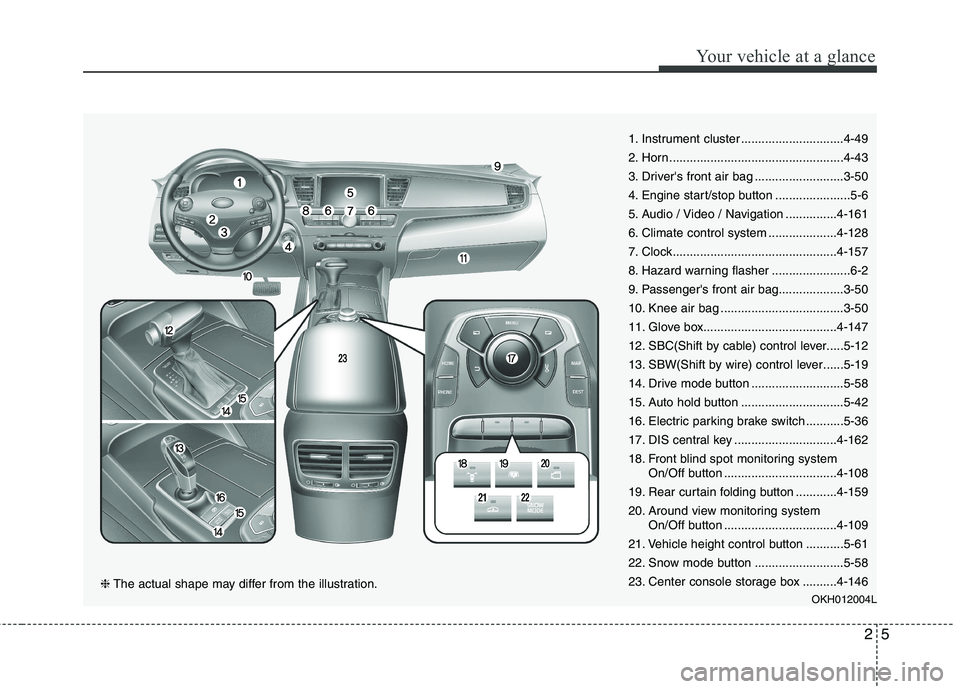
25
Your vehicle at a glance
1. Instrument cluster ..............................4-49
2. Horn...................................................4-43
3. Driver's front air bag ..........................3-50
4. Engine start/stop button ......................5-6
5. Audio / Video / Navigation ...............4-161
6. Climate control system ....................4-128
7. Clock................................................4-157
8. Hazard warning flasher .......................6-2
9. Passenger's front air bag...................3-50
10. Knee air bag ....................................3-50
11. Glove box.......................................4-147
12. SBC(Shift by cable) control lever.....5-12
13. SBW(Shift by wire) control lever......5-19
14. Drive mode button ...........................5-58
15. Auto hold button ..............................5-42
16. Electric parking brake switch ...........5-36
17. DIS central key ..............................4-162
18. Front blind spot monitoring systemOn/Off button .................................4-108
19. Rear curtain folding button ............4-159
20. Around view monitoring system On/Off button .................................4-109
21. Vehicle height control button ...........5-61
22. Snow mode button ..........................5-58
23. Center console storage box ..........4-146 OKH012004L
❈The actual shape may differ from the illustration.
Page 19 of 486
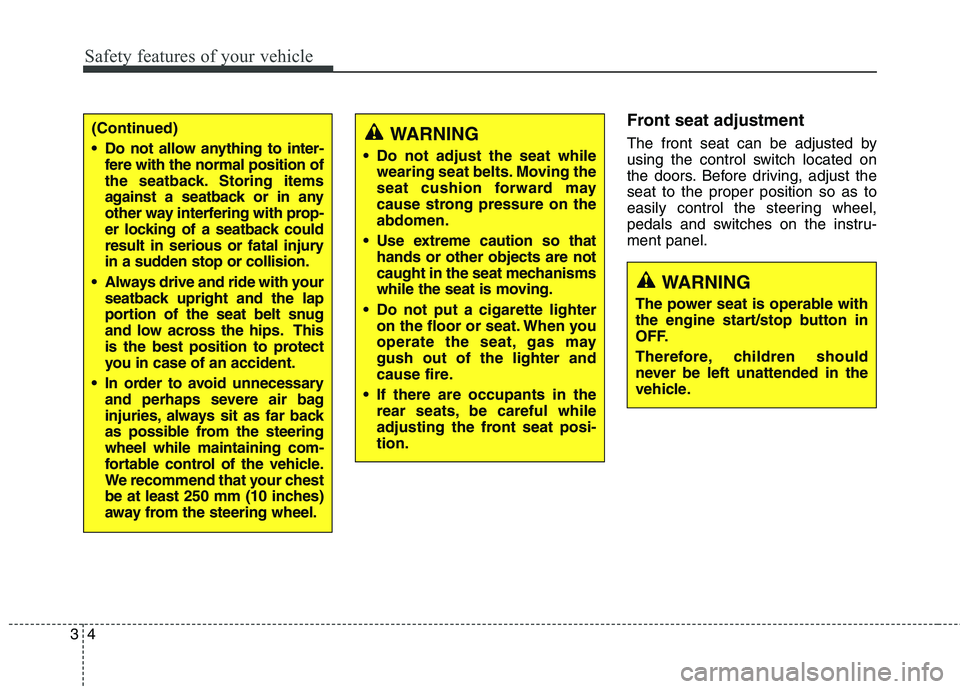
Safety features of your vehicle
4
3
Front seat adjustment
The front seat can be adjusted by
using the control switch located on
the doors. Before driving, adjust theseat to the proper position so as to
easily control the steering wheel,
pedals and switches on the instru-ment panel.
WARNING
The power seat is operable with
the engine start/stop button in
OFF.
Therefore, children should
never be left unattended in the
vehicle.
WARNING
Do not adjust the seat while wearing seat belts. Moving the
seat cushion forward may
cause strong pressure on theabdomen.
Use extreme caution so that hands or other objects are not
caught in the seat mechanisms
while the seat is moving.
Do not put a cigarette lighter on the floor or seat. When you
operate the seat, gas maygush out of the lighter and
cause fire.
If there are occupants in the rear seats, be careful while
adjusting the front seat posi-tion.(Continued)
Do not allow anything to inter-fere with the normal position of
the seatback. Storing items
against a seatback or in any
other way interfering with prop-
er locking of a seatback could
result in serious or fatal injury
in a sudden stop or collision.
Always drive and ride with your seatback upright and the lap
portion of the seat belt snug
and low across the hips. This
is the best position to protect
you in case of an accident.
In order to avoid unnecessary and perhaps severe air bag
injuries, always sit as far back
as possible from the steeringwheel while maintaining com-
fortable control of the vehicle.
We recommend that your chest
be at least 250 mm (10 inches)
away from the steering wheel.
Page 22 of 486
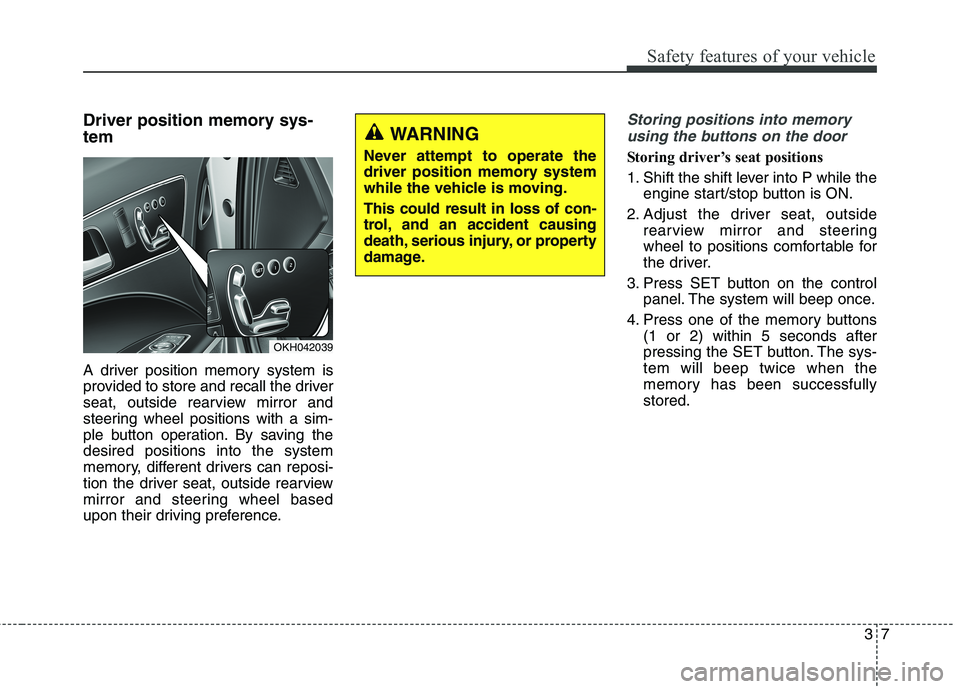
37
Safety features of your vehicle
Driver position memory sys- tem
A driver position memory system is
provided to store and recall the driver
seat, outside rearview mirror and
steering wheel positions with a sim-
ple button operation. By saving thedesired positions into the system
memory, different drivers can reposi-
tion the driver seat, outside rearview
mirror and steering wheel based
upon their driving preference.Storing positions into memoryusing the buttons on the door
Storing driver’s seat positions
1. Shift the shift lever into P while the engine start/stop button is ON.
2. Adjust the driver seat, outside rearview mirror and steering
wheel to positions comfortable for
the driver.
3. Press SET button on the control panel. The system will beep once.
4. Press one of the memory buttons (1 or 2) within 5 seconds after
pressing the SET button. The sys-tem will beep twice when the
memory has been successfullystored.
OKH042039
WARNING
Never attempt to operate the
driver position memory system
while the vehicle is moving. This could result in loss of con-
trol, and an accident causing
death, serious injury, or property
damage.
Page 23 of 486
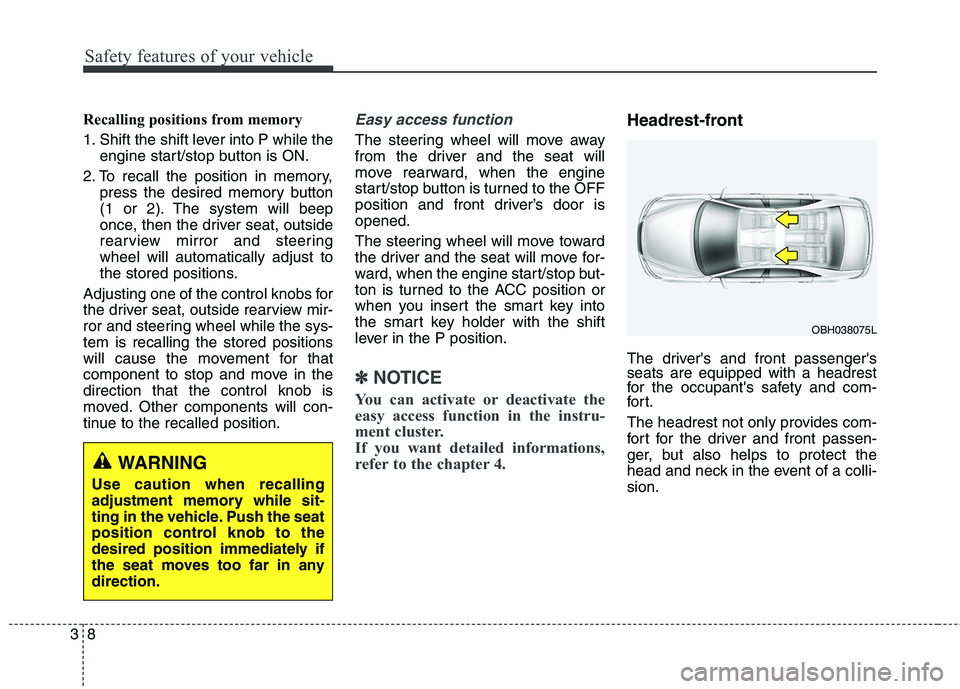
Safety features of your vehicle
8
3
Recalling positions from memory
1. Shift the shift lever into P while the
engine start/stop button is ON.
2. To recall the position in memory, press the desired memory button
(1 or 2). The system will beep
once, then the driver seat, outside
rearview mirror and steeringwheel will automatically adjust to
the stored positions.
Adjusting one of the control knobs for
the driver seat, outside rearview mir-
ror and steering wheel while the sys-tem is recalling the stored positions
will cause the movement for that
component to stop and move in thedirection that the control knob is
moved. Other components will con-
tinue to the recalled position.Easy access function
The steering wheel will move away
from the driver and the seat will
move rearward, when the engine
start/stop button is turned to the OFF
position and front driver’s door isopened.
The steering wheel will move toward
the driver and the seat will move for-
ward, when the engine start/stop but-
ton is turned to the ACC position or
when you insert the smart key into
the smart key holder with the shift
lever in the P position.
✽✽ NOTICE
You can activate or deactivate the
easy access function in the instru-
ment cluster.
If you want detailed informations,
refer to the chapter 4.
Headrest-front
The driver's and front passenger's seats are equipped with a headrest
for the occupant's safety and com-
for t.
The headrest not only provides com-
fort for the driver and front passen-
ger, but also helps to protect the
head and neck in the event of a colli-sion.
WARNING
Use caution when recalling
adjustment memory while sit-
ting in the vehicle. Push the seat
position control knob to the
desired position immediately if
the seat moves too far in anydirection.
OBH038075L
Page 27 of 486

Safety features of your vehicle
12
3
Rear seat adjustment
The rear seat can be adjusted by
using the control switches located on
the door.Forward, backward and seatback
angle (for power seat)
Push the control switch forward or
backward to move the seat to the
desired position. Release the switchonce the seat reaches the desiredposition.
WARNING
The power seat is operable with
the engine start/stop button in
OFF.
Therefore, children should never
be left unattended in the vehicle.
CAUTION
The power seat is driven by an electric motor. Stop operatingonce the adjustment is com-pleted. Excessive operationmay damage the electrical equipment.
When in operation, the power seat consumes a large amountof electrical power. To preventunnecessary charging system drain, don’t adjust the powerseat longer than necessarywhile the engine is not running.
(Continued)
(Continued)
Do not operate two or more power seat control switches atthe same time. Doing so may result in power seat motor orelectrical component malfunc-tion.
WARNING
Use extreme caution so that hands or other objects are not
caught in the seat mechanisms
while the seat is moving. Do not adjust the seat while
wearing seat belts. Moving the
seat cushion forward may
cause strong pressure on theabdomen.
WARNING
Do not operate the rear power
seat while the child seat isinstalled.
OKH032035
Page 36 of 486
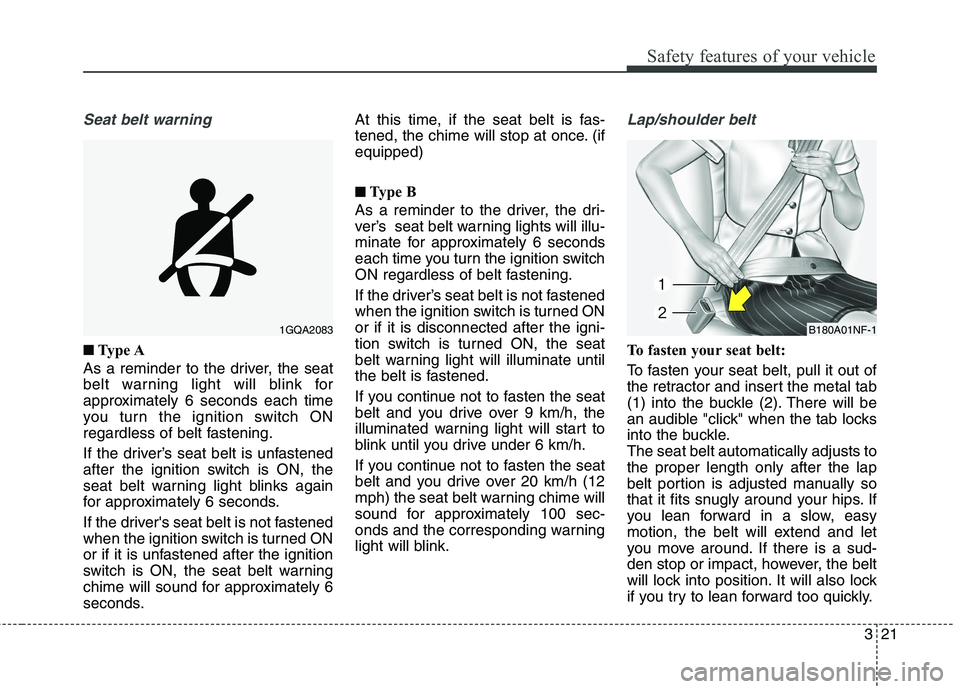
321
Safety features of your vehicle
Seat belt warning
■■
Type A
As a reminder to the driver, the seat
belt warning light will blink for
approximately 6 seconds each time
you turn the ignition switch ON
regardless of belt fastening.
If the driver’s seat belt is unfastened
after the ignition switch is ON, the
seat belt warning light blinks again
for approximately 6 seconds.
If the driver's seat belt is not fastened
when the ignition switch is turned ON
or if it is unfastened after the ignition
switch is ON, the seat belt warning
chime will sound for approximately 6
seconds. At this time, if the seat belt is fas-
tened, the chime will stop at once. (ifequipped)
■
■
Type B
As a reminder to the driver, the dri-
ver’s seat belt warning lights will illu-
minate for approximately 6 seconds
each time you turn the ignition switch
ON regardless of belt fastening.
If the driver’s seat belt is not fastened
when the ignition switch is turned ONor if it is disconnected after the igni-
tion switch is turned ON, the seat
belt warning light will illuminate until
the belt is fastened.
If you continue not to fasten the seat
belt and you drive over 9 km/h, the
illuminated warning light will start to
blink until you drive under 6 km/h.
If you continue not to fasten the seat
belt and you drive over 20 km/h (12
mph) the seat belt warning chime will
sound for approximately 100 sec-
onds and the corresponding warning
light will blink.
Lap/shoulder belt
To fasten your seat belt:
To fasten your seat belt, pull it out of
the retractor and insert the metal tab
(1) into the buckle (2). There will be
an audible "click" when the tab locks
into the buckle.The seat belt automatically adjusts tothe proper length only after the lap
belt portion is adjusted manually so
that it fits snugly around your hips. If
you lean forward in a slow, easy
motion, the belt will extend and let
you move around. If there is a sud-
den stop or impact, however, the belt
will lock into position. It will also lock
if you try to lean forward too quickly.
1GQA2083B180A01NF-1
Page 43 of 486
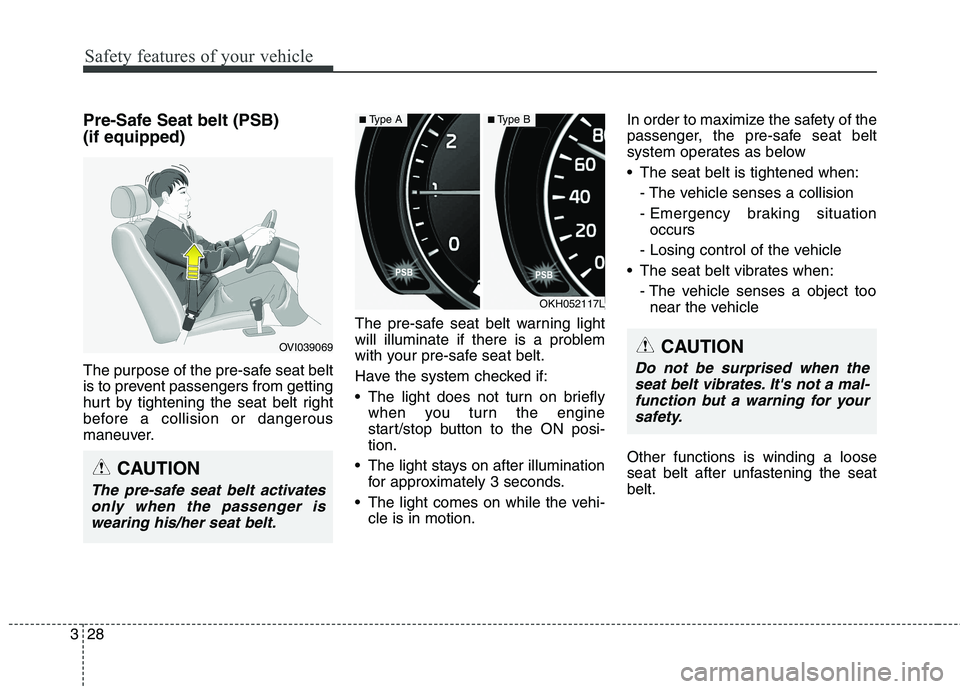
Safety features of your vehicle
28
3
Pre-Safe Seat belt (PSB) (if equipped)
The purpose of the pre-safe seat belt
is to prevent passengers from getting
hurt by tightening the seat belt right
before a collision or dangerous
maneuver. The pre-safe seat belt warning light
will illuminate if there is a problem
with your pre-safe seat belt.
Have the system checked if:
The light does not turn on briefly
when you turn the engine
start/stop button to the ON posi-tion.
The light stays on after illumination for approximately 3 seconds.
The light comes on while the vehi- cle is in motion. In order to maximize the safety of the
passenger, the pre-safe seat belt
system operates as below
The seat belt is tightened when:
- The vehicle senses a collision
- Emergency braking situationoccurs
- Losing control of the vehicle
The seat belt vibrates when: - The vehicle senses a object toonear the vehicle
Other functions is winding a loose
seat belt after unfastening the seatbelt.
OVI039069
OKH052117L
CAUTION
The pre-safe seat belt activates only when the passenger iswearing his/her seat belt.
CAUTION
Do not be surprised when the seat belt vibrates. It's not a mal-function but a warning for yoursafety.
■ Type A■Type B
Page 59 of 486
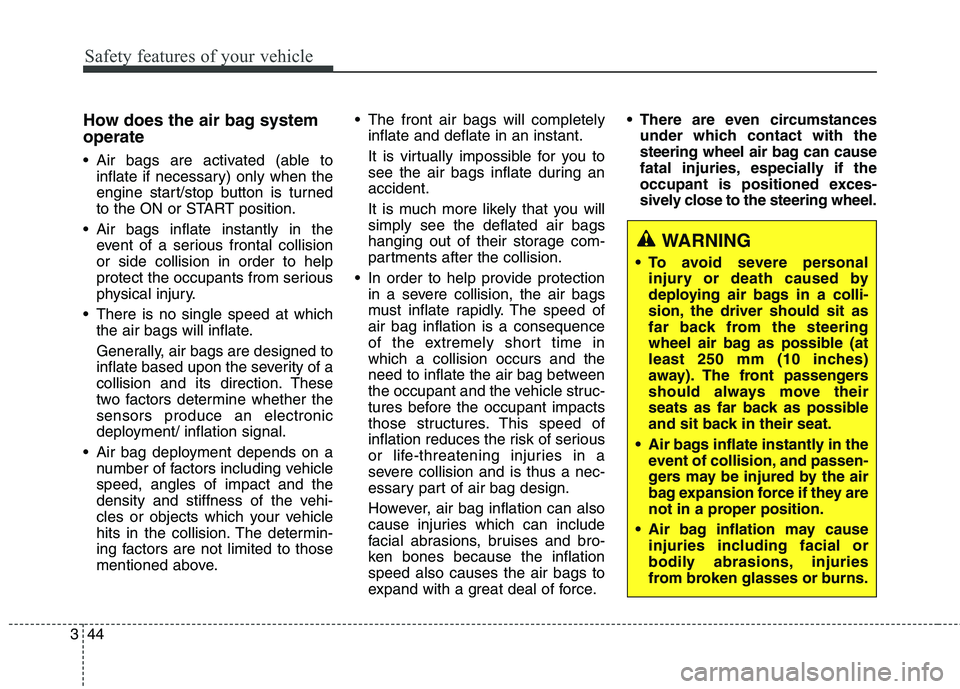
Safety features of your vehicle
44
3
How does the air bag system operate
Air bags are activated (able to
inflate if necessary) only when the
engine start/stop button is turned
to the ON or START position.
Air bags inflate instantly in the event of a serious frontal collisionor side collision in order to help
protect the occupants from serious
physical injury.
There is no single speed at which the air bags will inflate.
Generally, air bags are designed to
inflate based upon the severity of a
collision and its direction. These
two factors determine whether thesensors produce an electronic
deployment/ inflation signal.
Air bag deployment depends on a number of factors including vehiclespeed, angles of impact and the
density and stiffness of the vehi-
cles or objects which your vehicle
hits in the collision. The determin-
ing factors are not limited to those
mentioned above. The front air bags will completely
inflate and deflate in an instant.
It is virtually impossible for you to
see the air bags inflate during anaccident.
It is much more likely that you will simply see the deflated air bags
hanging out of their storage com-
partments after the collision.
In order to help provide protection in a severe collision, the air bags
must inflate rapidly. The speed ofair bag inflation is a consequence
of the extremely short time inwhich a collision occurs and the
need to inflate the air bag between
the occupant and the vehicle struc-
tures before the occupant impacts
those structures. This speed of
inflation reduces the risk of serious
or life-threatening injuries in a
severe collision and is thus a nec-
essary part of air bag design.
However, air bag inflation can also
cause injuries which can include
facial abrasions, bruises and bro-
ken bones because the inflationspeed also causes the air bags to
expand with a great deal of force. There are even circumstances
under which contact with the
steering wheel air bag can cause
fatal injuries, especially if the
occupant is positioned exces-
sively close to the steering wheel.
WARNING
To avoid severe personal injury or death caused by
deploying air bags in a colli-
sion, the driver should sit as
far back from the steering
wheel air bag as possible (at
least 250 mm (10 inches)
away). The front passengers
should always move their
seats as far back as possible
and sit back in their seat.
Air bags inflate instantly in the event of collision, and passen-
gers may be injured by the air
bag expansion force if they are
not in a proper position.
Air bag inflation may cause injuries including facial or
bodily abrasions, injuries
from broken glasses or burns.
Page 61 of 486
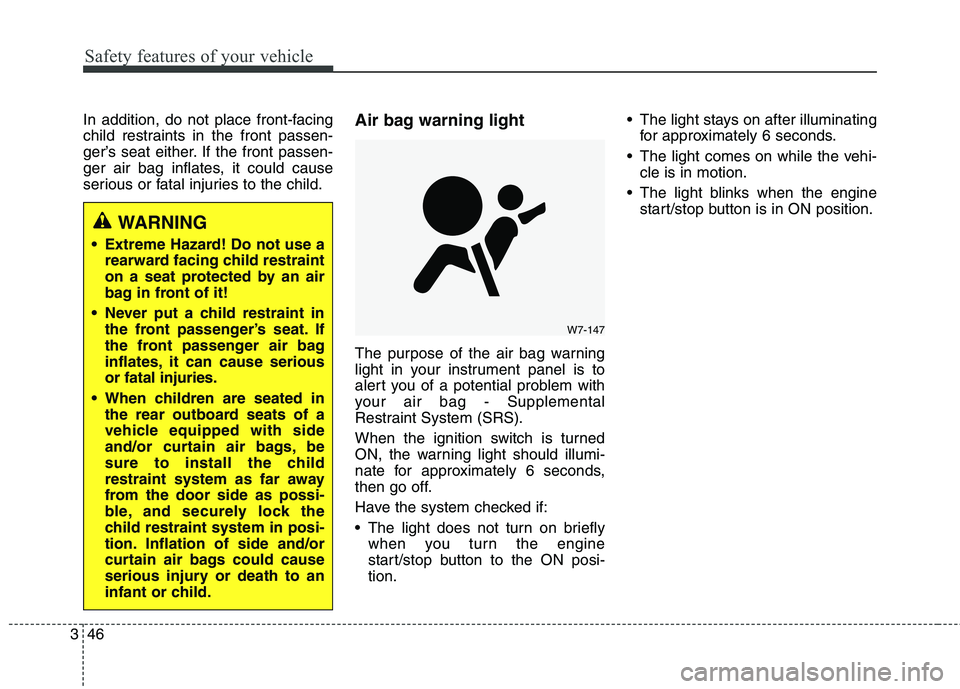
Safety features of your vehicle
46
3
In addition, do not place front-facing
child restraints in the front passen-
ger’s seat either. If the front passen-
ger air bag inflates, it could cause
serious or fatal injuries to the child. Air bag warning light
The purpose of the air bag warning
light in your instrument panel is to
alert you of a potential problem with
your air bag - Supplemental
Restraint System (SRS).
When the ignition switch is turned
ON, the warning light should illumi-
nate for approximately 6 seconds,
then go off.
Have the system checked if:
The light does not turn on briefly
when you turn the engine
start/stop button to the ON posi-tion. The light stays on after illuminating
for approximately 6 seconds.
The light comes on while the vehi- cle is in motion.
The light blinks when the engine start/stop button is in ON position.
WARNING
Extreme Hazard! Do not use a rearward facing child restraint
on a seat protected by an air
bag in front of it!
Never put a child restraint in the front passenger’s seat. If
the front passenger air bag
inflates, it can cause serious
or fatal injuries.
When children are seated in the rear outboard seats of a
vehicle equipped with side
and/or curtain air bags, be
sure to install the child
restraint system as far away
from the door side as possi-
ble, and securely lock the
child restraint system in posi-
tion. Inflation of side and/or
curtain air bags could cause
serious injury or death to an
infant or child.
W7-147
Page 62 of 486

347
Safety features of your vehicle
SRS components and func- tions
The SRS consists of the following components:
1. Driver's front air bag module
2. Passenger's front air bag module
3. Side air bag modules
4. Curtain air bag modules
5. Retractor pre-tensioner assem-blies
6. Air bag warning light
7. SRS control module (SRSCM)
8. Front impact sensors
9. Side impact sensors 10. Driver’s knee air bag module
11. Driver’s and front passenger’s
seat belt buckle sensors.*
* : if equipped
The SRSCM continually monitors all SRS components while the engine
start/stop button is ON to determine
if a crash impact is severe enough to
require air bag deployment or pre-
tensioner seat belt deployment.
The SRS air bag warning light " "
on the instrument panel will illumi-
nate for about 6 seconds after the
engine start/stop button is turned tothe ON position, after which the SRS
air bag warning light " " should goout.
OVI039100L
WARNING
If any of the following condi-
tions occurs, this indicates a
malfunction of the SRS. We rec-ommend that the system be
inspected by an authorized Kia
dealer.
The light does not turn on briefly when you turn the igni- tion ON.
The light stays on after illumi- nating for approximately 6seconds.
The light comes on while the vehicle is in motion.
The light blinks when the igni- tion switch is in ON position.